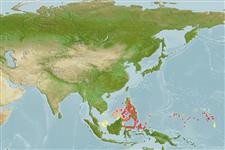Classification / Names
Common names from other countries
Main reference
Size / Weight / Age
Max length : 11.8 cm SL male/unsexed; (Ref. 9962); 10.3 cm SL (female)
Environment
Marine; demersal
Climate / Range
Tropical, preferred ?
Distribution
Short description
Dorsal
spines
(total): 13 - 15;
Dorsal
soft rays
(total): 18-20;
Anal
spines: 2;
Anal
soft rays: 19 - 21. Dorsal fin XIII to XV, 18 to 20 (usually XIV); membrane between spinous and segmented-ray portions notched deeper than half length of first segmented ray; membrane from posteriormost ray attaching to point ranging from between dorsal edge of caudal peduncle well in advance of caudal-fin base to dorsal edge of caudal fin just posterior to base (usually anterior to caudal-fin base); posteriormost anal-fin ray not bound by membrane to caudal peduncle; skin covering anal-fin spines and anterior segmented rays not modified in adult males; pectoral-fin rays 14 or 15 (15 only unilaterally, in only 2 of 46 specimens examined for character); dorsal procurrent caudal fin rays 6 to 8 (typically 7), ventral procurrent rays 6 to 8 (typically 7), total procurrent rays 12 to 15 (typically 14), segmented rays 13. Lacking nape cirrus. Orbital cirrus consisting of flattened central stalk with up to 7 branches on each lateral and medial margin; less than orbital diameter in females, ranging from less than to slightly greater than orbital diameter in males. Nasal cirrus short, ranging from ragged-edged flap to palmate flap with up to 16 irregular branches; lacking posterior canines; ventral margin of upper lip entire; dorsal margin of lower lip varying from entire to weakly, irregularly, and almost unnoticeably crenulate (irregularities almost entirely restricted to corners of lip). Males with well-developed, blade-like crest on head; females lack crest, but females generally at 6.8 to 8.6 cm SL with faint, ridge-like crest precursors; male crest uniformly dusky or covered with dusky spots or granular vermiculations; remainder of head either almost uniformly dusky or with fine, dusky spots on opercle. Male max. size 11.8 cm SL; female max. size, 10.3 cm SL.
IUCN Red List Status (Ref. 115185)
Threat to humans
Harmless
Human uses
More information
Age/SizeGrowthLength-weightLength-lengthLength-frequenciesMorphometricsMorphologyLarvaeLarval dynamicsRecruitmentAbundance
ReferencesAquacultureAquaculture profileStrainsGeneticsAllele frequenciesHeritabilityDiseasesProcessingMass conversion
Tools
Special reports
Download XML
Internet sources
Estimates of some properties based on models
Phylogenetic diversity index
PD50 = 0.5001 many relatives (e.g. carps) 0.5 - 2.0 few relatives (e.g. lungfishes)
Trophic Level
2.0 ±0.00 se; Based on food items.
Resilience
High, minimum population doubling time less than 15 months (Preliminary K or Fecundity.)
Vulnerability
Low to moderate vulnerability (27 of 100)
Price category
